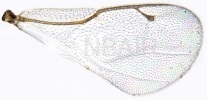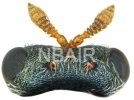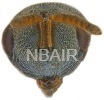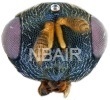Female: Body length 1.14-1.19 mm.
Colour: Head greenish black; eyes and ocelli dark reddish brown; antenna with scape, pedicel and anelli light yellow brown, flagellum dark brown dorsally and light brown laterally & ventrally; mandibles yellow with apical half dark brown; mesosoma greenish black; tegulae pale yellowish brown with brown dorsal infuscation; wings hyaline; veins pale yellowish brown; stigmal knob dark brown; discal pubescence brown; pubescence of body white; coxae concolourous with mesosoma; femora brownish yellow with paler apices; fore tibia off white apically and light yellow in basal half; fore tarsi light brown; mid and hind tibiae white; all tarsi white. Metasoma metallic blue with brown shade at hind margins of tergites.
Head: Distinctly reticulate and moderately setose; clypeus with longitudinal striations extending beyond clypeal margin, slightly convex along the median line, anterior margin slightly produced, almost straight; malar groove vaguely indicated. Head in dorsal view width 3.7x length; head in frontal view width 1.28x length; temple narrow, 0.4x eye length; POL 1.13x OOL; posterior margin of occiput sharply margined, occiput not carinate; eye length/width (1.94/0.69) = 2.8 in frontal view; frons width 3.6 mm; inter-torular distance 0.36 mm; malar space 1.61 mm in frontal view; mandibles with 4 teeth, apical two sharper, basal two blunt; scrobe deep, similarly sculptured as on rest of face. Antennae inserted below middle of face, distinctly above lower ocular line; toruli separated 0.54x their individual diameter; scape not exceeding median ocellus, 0.8x as long as eye; pedicel plus flagellum length 0.8x head width, pedicel shorter than F1, slightly longer than wide; anelli transverse, third anellus little longer than second, anelli together 0.42 x as long as pedicel; funicle not widening towards tip, with dense and moderately long pubescence; F1-F3 longer than wide, F1 little longer than F2 ( 1.1x) which is as long as F3; F4 and F5 transverse, equal, little shorter than F3 ( 0.9x); funicular segments with three irregular rows of sensillae; clava slightly wider than funicle, as long as 2.5 preceding segments combined and 2.1x as long as wide, sutures almost straight, area of micropilosity extending up to base of third segment.
Mesosoma: 5.437 / 4.34 (L/W) distinctly convex, uniformly reticulate punctate with dense white pubescence, reticulation finer on margins. Pronotal collar anteriorly sharp, not carinate. Mesoscutum 2.4x as broad as long (1.775: 4.278), notauli incomplete. Scutellum 0.9x as long as broad (2.173: 2.402), frenum absent. Dorsellum narrow with fine rugae. Propodeum moderately reticulate with short nucha, nuchal area finely reticulate, median carina almost complete, costulae indicated; plicae indicated only anteriorly, plical foveae deep; spiracle elongate ovate separated from hind margin of metanotum by distance little less than the diameter; post spiracular sulcus deep; callus with long white hairs. Prepectus small. Mesopleuron almost completely reticulate except for a narrow triangular smooth area below the wings. Metapleuron reticulate punctate. Fore wing length 2.1x width, basal part setose, speculum highly reduced in the form of a small area below parastigma; marginal fringe small, basal cell completely hairy; costal cell hairy except at the posterior margin; stigma moderately capitate. Relative lengths of SMV, 11.5; MV, 5.5; STV, 3.2; PMV, 4. Coxae distinctly reticulate; hind coxae with tuft of white hairs on the posterio-lateral margin, 1.14x as long as broad; hind femora 4.17x as long as broad ; hind tibiae with two unequal spurs.
Metasoma: Gaster ovate to almost circular, petiole transverse, less distinct, 0.79x as long as head plus mesosoma combined in profile; in dorsal view 1.42x as long as broad, posterior margin of T1 angularly produced, not collapsing; posterior margin of T2 distinctly produced and incised in the middle; T3 largest, slightly produced posteriorly with a small incision in the middle; hind margins of T3-T5 straight; ovipositor sheath slightly protruded; tergites smooth and nitid; hypopygium reaching middle of T5.
Male: Length range (0.90-1.13) mm. Metallic greenish-blue. Differs from female in having unique light yellow coloured and distinctly clubbed antennae with two anelli and six transverse funicular segments and dense pubescence; funicular segments gradually increasing in width towards the clava; clava widest at base and tapering towards tip; gaster compressed and elongate with distinct and polished petiole; brownish-yellow colouration on T2 and anterior half of T3; T2-T4 off white ventrally, ventral side of apex and T1 brown; Legs differ in colouration from female, femora in basal 1/3rd brown, middle 1/3rd yellow and apical 1/3rd white; fore tibiae off white; mid and hind tarsi white, leg segments little swollen especially tibiae.
 Female - antenna
Female - antenna
 Female - forewing
Female - forewing
 Male - vertex
Male - vertex
 Female - head front view
Female - head front view
 Male - head front view
Male - head front view
India: Karnataka.